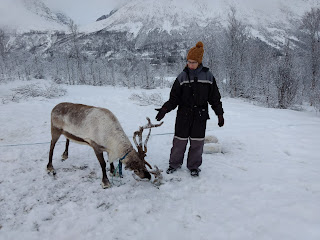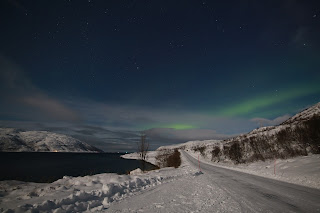Today, we head out in new snow for a day of dog sledding. We ride a bus from Tromso for 40 minutes in snowy conditions to a dog sledding operation. Here we don huge winter suits, mitts and a headlamp.
Next we are given instructions on how to drive the dogsled. Each sled is pulled by a team of 6. The front two are the leaders, the middle two are the weakest of the team and back two are the strongest. The dogs can't wait to go. They are jumping and barking as soon as they see us.
The sled is designed for one person to sit and one person to drive. The driver stands on the runners behind the sled. This allows the driver to jump off and push when they dogs need help up a hill. There are 3 brakes. The first is a pad about 16 inches by 12. It has some ridges on the bottom so it can be used to slow the sled down by stepping onto it. Sleds need to be slowed going downhill and at other times if you are about to overtake another sled. The second brake is for stopping. It is and aluminum sheet with jagged cuts on the bottom. When you stand on this, the dogs will stop. Step off it, and they will go. The third brake is the parking brake. It is an anchor which has to be sunk deep in packed snow to keep the dogs from taking off. The driver should not let go of the sled until the parking anchor is secure.
The dogs are ready and we are about to start. The first couple sled take off at a high rate of speed. The guy two sleds in front of me, failed to listen to the instruction and stood on the brake for the whole trip. My team wanted to go but I had to continually brake to not overtake the sled in front of me. About half way through the 7 mile course, we stopped to let that slow sled get way ahead.
The dogs love to run. On the uphill, they stop if you don't get off to help them. On the downhill, they run as fast as possible to avoid the sled from running into them.
We stopped to wait for about 15 minutes to make sure everyone was ok. The dogs didn't like that. They wanted to run.
Finally, toward the end of the ride, the sky cleared and it stopped snowing. What fun this was.






















































